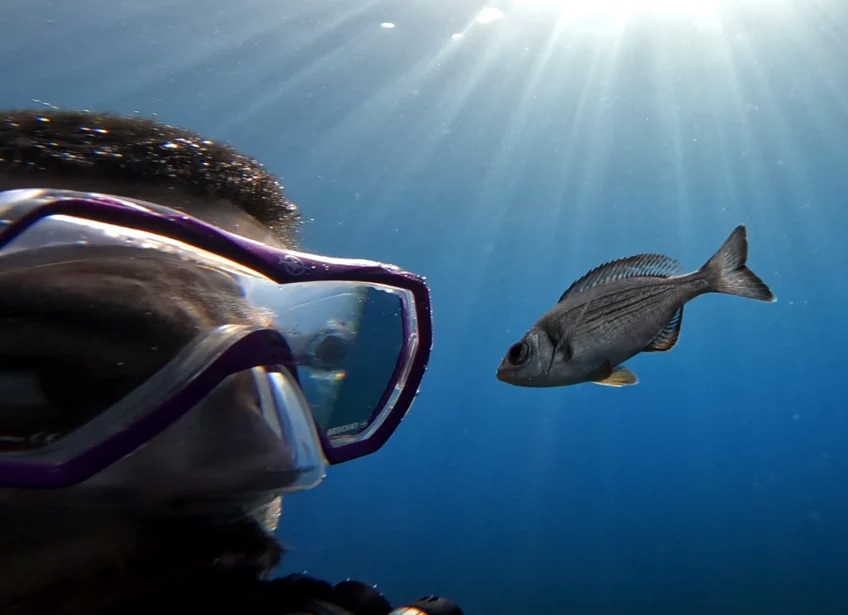We reach more than 65,000 registered users in Dec!! Register Now

Wild fish can recognize individual divers
- March 31, 2025
- 3 Views
- 0 Likes
- 0 Comment
Fish used visual differences between divers to recognize the person who rewarded them
For years, scientific divers at a research station in the Mediterranean Sea had a problem: at some point in every field season, local fish would follow them and steal food intended as experimental rewards. Intriguingly these wild fish appeared to recognize the specific diver who had previously carried food, choosing to follow only them while ignoring other divers. To find out if that was true, a team from the Max Planck Institute of Animal Behavior (MPI-AB) in Germany conducted a series of experiments while wearing a range of diving gear, finding that fish in the wild can discriminate among humans based on external visual cues.
© Maëlan Tomasek / Max Planck Institute of Animal Behavior
Now, a team from MPI-AB have asked; and the fish have responded. Wild fish can recognize individual humans. And, more than that, they follow specific divers they know will reward them. This finding, published in Biology Letters, lends credence to the possibility that fish can have differentiated relationships with specific humans.
The fish who volunteered
The research team conducted the study eight meters underwater at a research site in the Mediterranean Sea where populations of wild fish have become habituated to the presence of scientists. Their experiments took place in open water and fish participated in trials as “willing volunteers who could come and go as they pleased,” explains Katinka Soller, a bachelor student from MPI-AB who was co-first author on the study with Tomasek.The first experimental phase—the training—tested if fish could learn to follow an individual diver. The training diver, Soller, started by trying to attract the attention of local fish; she wore a bright red vest and fed fish while swimming a length of 50 meters. Over time, Soller removed the conspicuous cues until she wore plain dive gear, kept the food hidden, and fed fish only after they had followed her the full 50 meters.
Of dozens of fish species inhabiting the marine station, two species of seabream in particular willingly engaged in the training sessions. Sea bream are best known to us as fish that we buy to eat, yet they surprised the scientists by their curiosity and willingness to learn.
“Once I entered the water, it was a matter of seconds before I would see them swimming towards me, seemingly coming out of nowhere,” says Soller. Not only were bream learning to follow her, but the same individuals were showing up day after day to join the lessons. Soller even took to giving them names: “There was Bernie with two shiny silver scales on the back and Alfie who had a nip out of the tail fin,” she says.

© Behavioural Evolution Lab / MPI-AB
The two-diver test
This time Soller dived with Tomasek whose dive gear differed slightly from hers, notably in some colorful parts of the wetsuit and fins. Both divers started at the same point and then swam in different directions. On the first day, the fish followed both divers equally. “You could see them struggling to decide who to chase,” says Soller.
© Behavioural Evolution Lab / MPI-AB
But when Soller and Tomasek repeated the trials, this time wearing identical diving gear, the fish were unable to discriminate them. For the scientists, this was strong evidence that fish had associated the differences in the dive gear, most likely the colors, with each diver. “Almost all fish have color vision, so it is not surprising that the sea bream learned to associate the correct diver based on patches of color on the body,” says Tomasek.
Fish know how we look
Underwater, we do the same. “Faces are distorted by diving masks, so we usually rely on differences between wetsuits, fins, or other parts of the gear to recognize each other,” says Soller. With more time, the authors say, fish might have learned to pay attention to subtler human features, like hair or hands, to distinguish divers. “We already observed them approaching our faces and scrutinizing our bodies,” adds Soller. “It was like they were studying us, not the other way around.”This study corroborates many anecdotal reports of animals, including fish, recognizing humans; but it goes further by performing dedicated experiments in completely natural contexts. Finding that wild fish can quickly learn to use specific cues to recognize individual human divers, it stands to reason that many other fish species, our pets included, can recognize certain patterns to identify us, the scientists say. This mechanism is the foundation for special interactions between individuals, even across species.
 ">You can find this video on YouTube. Click on the image to be redirected there.
">You can find this video on YouTube. Click on the image to be redirected there.Wild fish recognize human divers
Meet the authors of the study and their underwater “volunteers” -- all of whom participated in a first-ever test of human recognition by fish in the wild."> Senior author Alex Jordan, who leads a group at MPI-AB, says: “It doesn’t come a shock to me that these animals, which navigate a complex world and interact with myriad different species every minute, can recognize humans based on visual cues. I suppose the most surprising thing is that we would be surprised they can. It suggests we might underestimate the capacities of our underwater cousins.”Adds Tomasek: “It might be strange to think about humans sharing a bond with an animal like a fish that sits so far from us on the evolutionary tree, that we don’t intuitively understand. But human-animal relationships can overcome millions of years of evolutionary distance if we bother to pay attention. Now we know that they see us, it’s time for us to see them.”
List of Referenes
- Maëlan Tomasek, Katinka Soller, Alex Jordan. Wild fish use visual cues to recognize individual divers. Biology Letters, 2025; 21 (2) DOI: 10.1098/rsbl.2024.0558
Cite This Article as
No tags found for this post









